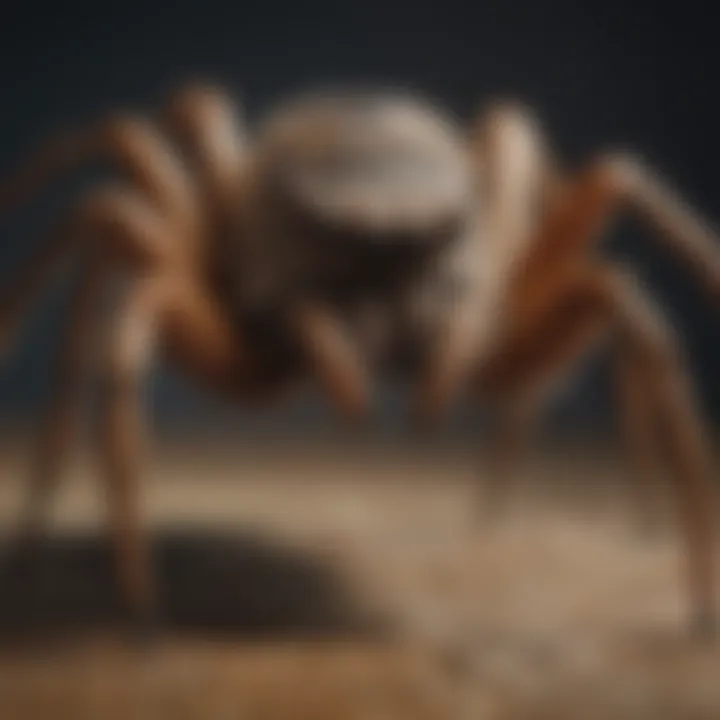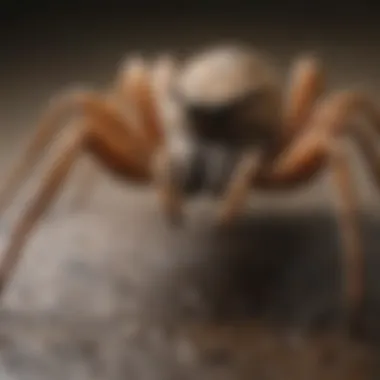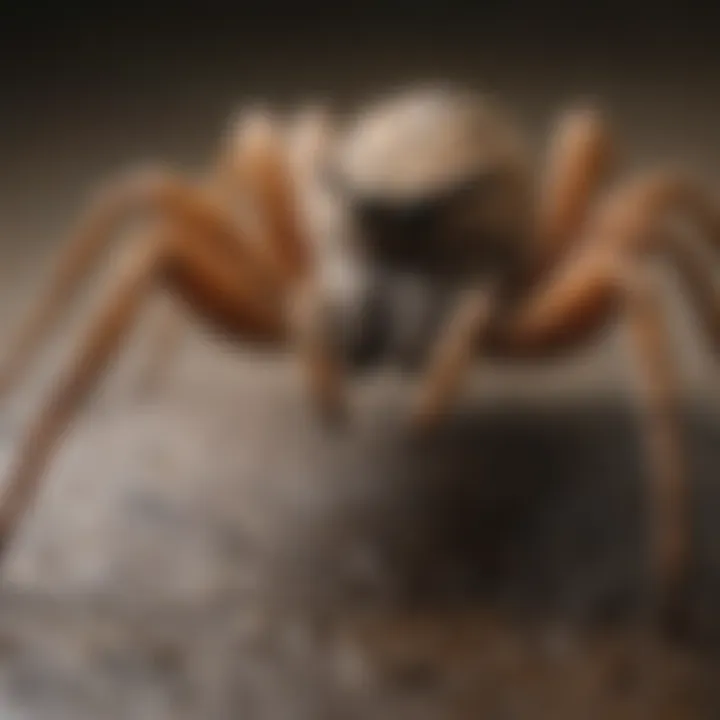Comprehensive Guide to Effective Wolf Spider Spraying Techniques


Preventive Pest Control Strategies
When it comes to effectively managing wolf spiders and other pests, implementing preventive pest control strategies is key to maintaining a pest-free environment. One crucial aspect of this is safeguarding your house exterior. Start by meticulously sealing cracks and crevices around your property to block potential entry points for spiders and other pests. Clearing debris such as woodpiles and overgrown vegetation near your home can also help in deterring wolf spiders from making themselves at home. Additionally, take proactive measures to prevent pests from entering by installing door sweeps and maintaining screens on windows and doors to keep them tightly sealed.
Yard maintenance is another vital component of preventing pest infestations. Engage in essential yard care routines like regularly mowing the lawn and trimming bushes to eliminate hiding spots for pests. Implement methods such as removing standing water sources to keep your yard pest-free. Indoors, focus on maintaining a clean environment by following expert cleaning tips and techniques. Regular vacuuming, sweeping, and decluttering can significantly reduce the likelihood of wolf spiders taking up residence in your home. Consider using natural repellents like essential oils to further deter pests while maintaining a pest-resistant indoor environment.
Proper garbage disposal is essential in preventing pest infestations. Implement efficient waste disposal methods such as tightly sealing trash cans and disposing of garbage regularly to avoid creating attractive environments for pests. Emphasize the importance of proper garbage disposal to all household members to ensure a unified effort in pest prevention. Additionally, explore innovative ways to safeguard your home beyond traditional methods. This could include incorporating natural pest deterrents like plants that repel spiders or utilizing ultrasonic pest repellents for an added layer of protection.
Identifying Pest Risk Areas
To effectively combat wolf spiders and other pests, it is crucial to identify pest risk areas in and around your property. Start by inspecting moisture-prone areas in your home to pinpoint damp conditions that may attract pests. Implement tips for preventing infestations in these areas, such as using dehumidifiers to reduce humidity levels and fixing leaky pipes promptly. Conduct a thorough inspection of crack
Introduction
Understanding Wolf Spiders
Wolf spiders are known for their unique physical characteristics, behavioral patterns, and habitat preferences, all of which play a significant role in pest control efforts.
Physical Characteristics
One key aspect of wolf spiders' physical characteristics is their distinct eye arrangement, with a combination of both large principal eyes and smaller secondary eyes. This feature gives them excellent eyesight, crucial for their hunting abilities. Their agile and robust bodies enable them to move swiftly, making them adept predators in various environments. While their appearance may instill fear, understanding these physical traits is essential for targeted control measures.
Behavioral Patterns
Wolf spiders exhibit solitary behavior and do not spin webs to catch prey. Instead, they actively hunt for insects, making them challenging to trap using traditional methods. Their hunting techniques involve stalking and pouncing on their prey, indicative of their predatory nature. This behavior influences the choice of spraying techniques to effectively target and eliminate wolf spiders within a given area.
Habitat Preferences
Wolf spiders thrive in outdoor environments such as grasslands, forests, and gardens, preferring areas with ample ground cover and hiding spots. They may also venture indoors seeking shelter and prey, especially during cooler seasons. Understanding their habitat preferences is essential for implementing targeted spraying strategies both indoors and outdoors to control populations effectively.
Significance of Pest Control
Effective pest control measures are crucial in managing wolf spider populations due to the potential health risks, structural damage, and cosmetic concerns they pose.
Health Risks
Wolf spiders can deliver venomous bites that, while not typically fatal to humans, may cause localized pain, swelling, and discomfort. Vulnerable individuals, such as children and elderly persons, are particularly at risk of adverse reactions. Implementing pest control measures helps minimize the likelihood of encounters and potential bites, safeguarding the health and well-being of occupants.
Structural Damage


In their quest for shelter and prey, wolf spiders may inadvertently cause structural damage by creating burrows or nests in walls, ceilings, and other concealed areas. These activities can weaken structural integrity over time, leading to issues such as cracks, holes, and compromised building materials. By prioritizing pest control, property owners can mitigate the risk of structural damage and preserve the aesthetics and functionality of their premises.
Cosmetic Concerns
The presence of wolf spiders in homes or businesses can also raise cosmetic concerns, especially for those averse to encountering these arachnids. Whether through visible sightings, discarded exoskeletons, or silk-lined retreats, their presence can detract from the overall aesthetics of a space, causing discomfort and unease. Addressing such concerns through targeted spraying efforts can enhance the visual appeal and comfort of the environment, creating a more hospitable setting for occupants and visitors.
Preparation Phase
In the realm of pest control, the preparation phase stands as a fundamental pillar to ensure the efficacy of wolf spider spraying. This critical stage sets the groundwork for a successful extermination process by laying the foundation for accurate identification and treatment strategies. As homes and businesses encounter the menace of wolf spiders, it becomes imperative to undertake a meticulous preparation phase to tackle the issue proactively.
Identifying Infestation
Common Signs
Delving into the depths of wolf spider infestation, the identification of common signs serves as a pivotal aspect of the preparation phase. Common signs, such as the presence of webs in secluded corners or the sudden appearance of spider bites on occupants, provide crucial insights into the extent of the infestation. These visible cues not only indicate the presence of wolf spiders but also offer a glimpse into their nesting areas and movement patterns.
Considering the overall goal of effective pest control, common signs play a vital role in alerting homeowners and business owners to the imminent threat posed by these arachnids. The key characteristic of common signs lies in their visibility and direct correlation to spider activity, making them a popular choice for inclusion in this article. By recognizing these signs early on, individuals can take proactive measures to eliminate wolf spiders before they reproduce and spread further.
Inspection Tips
Embarking on the journey of inspection tips during the preparation phase offers a strategic advantage in the battle against wolf spiders. Inspection tips encompass a range of techniques, such as using flashlights to inspect dark crevices or conducting thorough searches in cluttered areas where spiders are likely to hide. These tips not only aid in pinpointing spider hotspots but also contribute to a comprehensive assessment of the infestation.
The unique feature of inspection tips lies in their proactive nature, guiding individuals towards areas of potential infestation before visible signs manifest. By integrating inspection tips into this article, readers gain valuable insights into the proactive measures essential for effective pest control. Although inspection tips require time and diligence, their advantages in early detection and precise targeting of spider habitats make them invaluable in the preparation phase.
Safety Measures
Protective Gear
When navigating the terrain of wolf spider spraying, the incorporation of protective gear emerges as a crucial safety measure during the preparation phase. Protective gear, including gloves, masks, and long-sleeved clothing, acts as a shield against potential spider bites and exposure to chemical agents. The key characteristic of protective gear lies in its ability to safeguard individuals performing pest control activities, making it a beneficial choice for inclusion in this article.
The unique feature of protective gear rests in its role as a preventive barrier, minimising risks associated with contact with spiders or chemicals. By emphasising the importance of protective gear in this guide, readers gain a heightened awareness of the safety precautions necessary to execute spraying procedures effectively. Despite potential disadvantages such as discomfort or restricted movement, the advantages of protecting oneself from harm outweigh the temporary inconveniences.
Ventilation Requirements
Navigating the intricate landscape of ventilation requirements is pivotal in ensuring a safe and controlled spraying environment during the preparation phase. Adequate ventilation, achieved through open windows or fans, facilitates the dispersion of sprayed chemicals and prevents the accumulation of fumes in enclosed spaces. The key characteristic of ventilation requirements lies in their capacity to maintain air quality and reduce the risk of respiratory issues, making them a popular choice for incorporation in this article.
The unique feature of ventilation requirements centres on their role in promoting a healthy working environment, fostering a balance between effective pest control and occupant safety. By outlining ventilation requirements in this guide, readers gain insights into the optimal conditions necessary for a successful spraying process. While challenges such as coordinating airflow in certain spaces may arise, the advantages of prioritising ventilation far outweigh the potential drawbacks.
Choosing the Right Pesticide


When it comes to effectively managing wolf spiders, choosing the right pesticide is a crucial decision that can significantly impact the success of pest control efforts. In this article, we dive deep into the aspects of selecting the most appropriate pesticide for combating wolf spiders. From understanding the difference between natural and synthetic options to exploring specific formulations, we ensure that you are well-equipped to make an informed choice tailored to your unique situation.
Understanding Chemical Options
Natural vs. Synthetic
Natural and synthetic pesticides present distinct characteristics that influence their efficacy in tackling wolf spider infestations. Natural pesticides are derived from natural sources and are favored for their eco-friendly profile and reduced impact on the environment. On the other hand, synthetic pesticides are chemically formulated for targeted pest control, offering quick and potent solutions.
In this article, we analyze the advantages and disadvantages of natural and synthetic pesticides in the context of combating wolf spiders. Natural pesticides boast biodegradability and lower toxicity levels, making them a safer option for households with children or pets. Conversely, synthetic pesticides often provide quicker results and longer-lasting effects, essential for severe infestations.
Specific Formulations
Specific formulations play a pivotal role in the efficacy of pesticides against wolf spiders. Each formulation is designed to target particular aspects of pest behavior or biology, ensuring a more tailored approach to pest control. Understanding the specific formulations available allows for a more strategic and effective pesticide selection process.
Within this article, we delve into the unique features of various pesticide formulations and their advantages and disadvantages in managing wolf spider populations. From baits and sprays to residual concentrates, each formulation presents distinct benefits in addressing different stages of infestation and target areas.
Eco-Friendly Alternatives
Organic Products
Organic products offer a sustainable and environmentally conscious alternative for combating wolf spiders. Derived from natural ingredients, organic products provide effective pest control solutions while minimizing harmful effects on non-target organisms and ecosystems.
This article sheds light on the key characteristics of organic products, emphasizing their eco-friendly nature and safe application in residential and commercial spaces. By exploring organic pesticides' unique features and benefits, readers gain insight into a chemical-free approach to managing wolf spider populations.
Non-Toxic Solutions
Non-toxic solutions represent a safe and family-friendly option for controlling wolf spiders without compromising human health or the environment. These innovative products utilize alternative mechanisms to repel or eliminate pests, offering a sustainable and non-intrusive pest control strategy.
In this comprehensive guide, we provide detailed descriptions of non-toxic solutions and their advantages and disadvantages in wolf spider management. From ultrasonic devices to botanical repellents, readers discover a range of effective pest control alternatives that prioritize safety and sustainability.
Application Techniques
In the realm of pest control, application techniques play a pivotal role in effectively dealing with wolf spiders. The approach taken during spraying can significantly impact the success of the treatment. Understanding the specific methods and best practices for application is crucial to ensure the desired outcomes are achieved. This section delves into the meticulous aspects of applying pesticides for tackling wolf spider infestations, offering insights into indoor and outdoor strategies.
Indoor Spraying
Target Areas
When it comes to indoor spraying for wolf spiders, identifying target areas is essential for precise and effective treatment. Target areas typically include spaces where wolf spiders are commonly found, such as basements, attics, and crawl spaces. These areas provide ideal habitats for wolf spiders, making them focal points for pesticide application. By focusing on these specific zones, homeowners can directly combat the infestation at its source, enhancing the overall effectiveness of the spraying process.


Indoor spraying in target areas is advantageous as it helps concentrate the pesticide in areas most frequented by wolf spiders, maximizing the chances of eradicating them. However, one drawback of exclusively targeting specific areas is the potential oversight of spider hiding spots outside these zones, necessitating thorough inspection and treatment of all potential harborages within the premises.
Precision Methods
Precision methods in indoor spraying involve meticulous techniques aimed at reaching challenging areas where wolf spiders may hide. These methods encompass strategies such as crack and crevice treatment, spot application, and localized spraying. By employing precision methods, pest control professionals can ensure that the pesticide reaches inaccessible nooks and crannies where wolf spiders typically dwell, effectively eliminating them.
The key characteristic of precision methods lies in their ability to deliver targeted and concentrated pesticide application, minimizing wastage and environmental impact. This approach is particularly beneficial in households with children or pets, as it reduces the exposure of non-target organisms to pesticides. Despite its advantages, precision spraying requires thorough training and expertise to execute correctly, highlighting the importance of engaging skilled professionals for optimal results.
Outdoor Treatment
When addressing wolf spider infestations, outdoor treatment plays a critical role in preventing reinfestation and fortifying the perimeter against pest intrusion. Outdoor strategies primarily focus on creating a barrier around the property to repel and eliminate spiders before they can infiltrate indoor spaces.
Perimeter Control
Perimeter control involves the systematic application of pesticides along the exterior boundaries of the property to deter wolf spiders from entering. By establishing a protective barrier, homeowners can proactively ward off potential infestations and safeguard their living spaces from pest threats. The key characteristic of perimeter control is its preventative nature, offering long-term protection against outdoor pests like wolf spiders.
Implementing perimeter control is a popular choice for pest management as it provides a proactive solution to keeping spiders at bay. However, a potential disadvantage of this method is the need for regular reapplications, especially in high-traffic outdoor areas with frequent spider activity. Effective perimeter control relies on consistent monitoring and maintenance to uphold its protective efficacy.
Lawn and Garden Considerations
Incorporating lawn and garden considerations into outdoor treatment plans enhances the overall effectiveness of pest control measures against wolf spiders. Outdoor spaces serve as prime habitats for these arachnids, making it crucial to address potential infestation sources beyond the confines of the structure. By extending treatment to encompass lawns, gardens, and landscaping features, homeowners can create a comprehensive shield against pest incursions.
Lawn and garden considerations offer a holistic approach to pest management by targeting wolf spider populations in outdoor environments where they thrive. This method strategically disrupts the spiders' habitat, reducing their numbers and minimizing the risk of indoor migration. However, one downside of incorporating outdoor spaces into treatment plans is the potential impact on beneficial organisms in the ecosystem, underscoring the importance of using eco-friendly and targeted products to preserve biodiversity.
Post-Spraying Guidelines
Monitoring and Evaluation
Effectiveness Assessment
The effectiveness assessment is a critical aspect of post-spraying guidelines as it allows for the measurement of the pesticide's impact on the wolf spider population. By evaluating the effectiveness of the treatment, homeowners and pest control professionals can gauge the success of the spraying efforts and make informed decisions moving forward. Key characteristics of effectiveness assessment include systematic data collection, comparison of pre- and post-treatment spider activity levels, and observation of any residual spiders. This method is popular because it provides tangible evidence of the treatment's success and guides future pest management strategies. One unique feature of effectiveness assessment is its ability to quantify the reduction in wolf spider sightings post-spraying, thereby offering a clear indication of the treatment's impact. While effectiveness assessment is beneficial in tracking progress, its disadvantage lies in its reliance on accurate data collection and interpretation which may require expertise in pest control.
Follow-Up Procedures
Follow-up procedures are crucial in ensuring the long-term success of pest control measures. These procedures involve continued monitoring of wolf spider activity post-spraying to address any potential re-infestation promptly. The key characteristic of follow-up procedures is their proactive nature, allowing for early detection of any resurgence in spider populations and swift action to prevent a full-blown infestation. This approach is popular among homeowners as it emphasizes the importance of ongoing vigilance in maintaining a pest-free environment. A unique feature of follow-up procedures is their role in adjusting treatment strategies based on monitoring results, enabling a tailored approach to pest management. While advantageous in preventing re-infestations, a potential disadvantage of follow-up procedures is the need for consistency and dedication to regular inspections, which may require time and effort from homeowners.
Preventive Measures
Maintenance Tips
Maintenance tips are essential in preventing future wolf spider infestations by addressing conducive conditions that might attract these pests. By implementing regular maintenance practices, such as sealing cracks and crevices, reducing clutter, and proper food storage, homeowners can create an inhospitable environment for wolf spiders. The key characteristic of maintenance tips is their focus on sustainable pest prevention through simple yet effective actions that limit spider access and shelter. This approach is popular among environmentally conscious individuals seeking non-intrusive methods of pest control. A unique feature of maintenance tips is their emphasis on long-term solutions rather than temporary fixes, promoting a holistic approach to pest management. While advantageous in reducing reliance on chemical treatments, a potential disadvantage of maintenance tips is the need for consistent upkeep and diligence to maintain a pest-free home.
Regular Inspections
Regular inspections are fundamental to proactive pest management as they allow for the early detection of potential pest issues, including wolf spider infestations. By conducting frequent inspections of indoor and outdoor spaces, homeowners can identify and address pest vulnerabilities promptly. The key characteristic of regular inspections is their preventive nature, aiming to catch pest problems before they escalate into full-blown infestations. This approach is popular among those who prioritize a proactive approach to pest control and value early intervention. A unique feature of regular inspections is their role in promoting a habit of awareness and observation, cultivating a vigilant attitude towards pest prevention. While advantageous in detecting pests early on, a potential disadvantage of regular inspections is the time and effort required to conduct thorough assessments regularly, which may be challenging for busy households.



